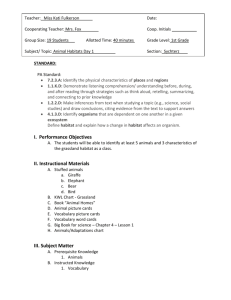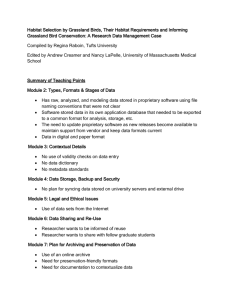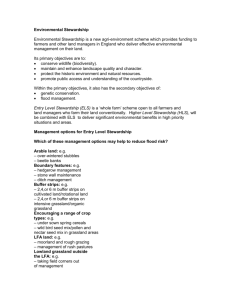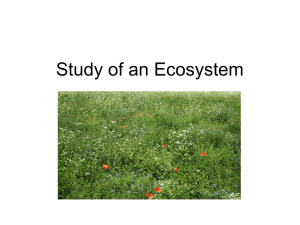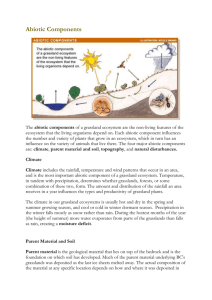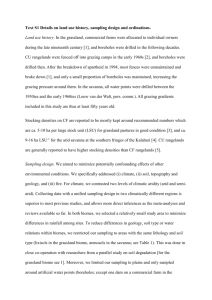Acid Grassland - London Biodiversity Partnership
advertisement
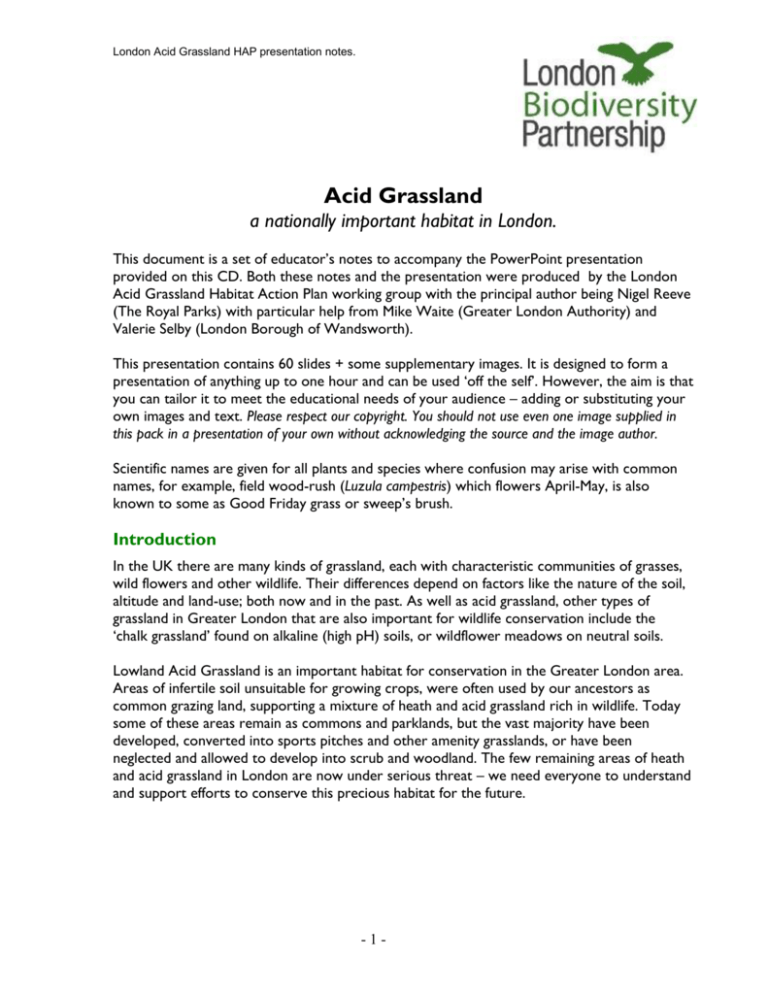
London Acid Grassland HAP presentation notes. Acid Grassland a nationally important habitat in London. This document is a set of educator’s notes to accompany the PowerPoint presentation provided on this CD. Both these notes and the presentation were produced by the London Acid Grassland Habitat Action Plan working group with the principal author being Nigel Reeve (The Royal Parks) with particular help from Mike Waite (Greater London Authority) and Valerie Selby (London Borough of Wandsworth). This presentation contains 60 slides + some supplementary images. It is designed to form a presentation of anything up to one hour and can be used ‘off the self’. However, the aim is that you can tailor it to meet the educational needs of your audience – adding or substituting your own images and text. Please respect our copyright. You should not use even one image supplied in this pack in a presentation of your own without acknowledging the source and the image author. Scientific names are given for all plants and species where confusion may arise with common names, for example, field wood-rush (Luzula campestris) which flowers April-May, is also known to some as Good Friday grass or sweep’s brush. Introduction In the UK there are many kinds of grassland, each with characteristic communities of grasses, wild flowers and other wildlife. Their differences depend on factors like the nature of the soil, altitude and land-use; both now and in the past. As well as acid grassland, other types of grassland in Greater London that are also important for wildlife conservation include the ‘chalk grassland’ found on alkaline (high pH) soils, or wildflower meadows on neutral soils. Lowland Acid Grassland is an important habitat for conservation in the Greater London area. Areas of infertile soil unsuitable for growing crops, were often used by our ancestors as common grazing land, supporting a mixture of heath and acid grassland rich in wildlife. Today some of these areas remain as commons and parklands, but the vast majority have been developed, converted into sports pitches and other amenity grasslands, or have been neglected and allowed to develop into scrub and woodland. The few remaining areas of heath and acid grassland in London are now under serious threat – we need everyone to understand and support efforts to conserve this precious habitat for the future. -1- London Acid Grassland HAP presentation notes. Slide 1. Title: Acid Grassland a nationally important habitat in London. Slide 2. What is Acid Grassland? Lowland acid grassland develops on low-nutrient, acidic soils (pH 4 to 5.5) overlying acidic rocks or on the free-draining, gravelly and sandy soils found in many parts of London. It often occurs as an integral part of lowland heath landscapes, commons and parklands. Grazing (or cutting) is needed to prevent invasion by scrub and trees. Upland acid grassland is only found at over 250 metres above sea level and does not occur in the London area. Slide 3. Acid grassland is nationally important. Lowland Acid Grassland is a UK Biodiversity Action Plan habitat and as such is a top priority for wildlife conservation nationally. Several plant, invertebrate and bird species found in acid grassland are protected under the Wildlife and Countryside Act 1981 In England and Wales there are 271 Sites of Special Scientific Interest (SSSIs) with the habitat listed as the main reason for their special status. A number of Special Areas of Conservation (SAC) are designated under the European Habitats Directive. These include Epping Forest, Wimbledon Common and Richmond Park, all of which include substantial areas of London’s acid grasslands. Acid grasslands are important in London: In London there are an estimated 1,300 hectares of lowland acid grassland, which contributes about 4% to the national resource. The acid grasslands of Greater London, south Essex and north west Kent are an important home for a distinctive community of insects and spiders – many of which are nationally scarce. This community is collectively known as the ‘Thames Terrace Invertebrates’. Slide 4. Acid grassland has . . . This slide simply sets out the range of plants and animals to be covered in the talk Fine grasses, wild flowers, fungi and lichens, tussocky structure often with ant hills, invertebrates, reptiles, mammals and birds. Slides 5-8. Some sites have over 50 species of grasses rushes and sedges. Only the best sites in London will have this many, but also many sites are little-known and a good species list can often be quickly discovered. Of particular interest are the fine-leaved grasses, including common bent (Agrostis capillaris (= A. tenuis)), red and sheep’s fescues (Festuca rubra, Festuca ovina), mat grass (Nardus stricta) and many others. In areas that are less well drained, you will see tussocky grasses such as tufted hair-grass Deschampsia cespitosa and purple moor-grass (Molinia caerulea) , along with a range of sedges (Carex species), rushes (Juncus species) and wood-rushes (Luzula species). -2- London Acid Grassland HAP presentation notes. The 10 species selected here are fairly easily to recognise in photographs. Wavy hair-grass (Deschampsia flexuosa); fine-leaved sheep’s fescue (Festuca filiformis); glaucous sedge (Carex flacca); mat-grass (Nardus stricta); early hair-grass (Aira praecox) brown sedge (Carex distica) – a scarce species in London, here photographed in Richmond Park; field wood-rush (Luzula campestris) a very common species; hard rush (Juncus inflexus); heath wood-rush (Luzula multiflora). Note: You can edit/add to this plant list to suit your audience and what is found on your site. Slides 9-14. . . . and lots of wild flowers too. Most of the wildflowers in Acid Grassland are quite small and you need to get close to really appreciate them. One of the largest is the harebell (Campanula rotundifolia) with large blue belllike flowers late in the summer (July-September). Although small, other species can also be spectacular. The tiny russet flowers of sheep's sorrel (Rumex acetosella) make a beautiful reddish flush in May (see slide 52). Others stud the sward like gems: tormentil (Potentilla erecta); bird’s-foot (Ornithopus perpusillus) has tiny pinkish flowers just a few millimetres across; heath bedstraw (Galium saxatile) has clusters of tiny white flowers which when abundant can look almost like foam amongst the grass; mouse-ear hawkweed (Pilosella officinarum) has lemon yellow dandelion-like flowers and downy leaves (like a mouse’s ear). Many species are not exclusive to acid grassland but thrive in this habitat because of low soil nutrient levels and a lack of competition from coarse grasses. These include bird’s-foot-trefoil (Lotus corniculatus); common mouse-ear (Cerastium fontanum); lesser stitchwort (Stellaria graminea); wall speedwell; (Veronica arvensis); germander speedwell (Veronica chamaedrys) and others such as common stork’s-bill (Erodium cicutarium). Heath speedwell (Veronica officinalis) and heath dog-violet (Viola canina) are quite uncommon species on acid grasslands in London. Nationally scarce plants found in London's acid grasslands include clustered clover (Trifolium glomeratum), upright chickweed (Moenchia erecta) and autumn squill (Scilla autumnalis). You can edit or add to this list to suit your audience and what is found on your site. Slide 15. Mature Acid Grasslands are also important for fungi. Fungi play a vital ecological role in grasslands: as decomposers, in helping to maintain soil structure and nutrient levels, as a food source, and for their mutualistic associations with plants. One of the best known of these are the mycorrhizal (‘fungus-root’) associations with trees, but almost all plants form these beneficial relationships with soil fungi. The fungal hyphae (‘roots’ of the fungus) widely infiltrate the soil and gather nutrients and water which are then made available to the plant in exchange for carbohydrates (sugars). Such services are particularly important in nutrient-poor conditions such as those in acid grassland. Although most plants can grow without their fungal partners, they do much better when they are present. However, some plants, such as the orchids, are entirely dependent on fungi. Waxcaps (Hygrocybe species) are often beautifully coloured (red, yellow and pink) mushrooms but are found only rarely on London sites. A diverse fungus community including waxcaps is a -3- London Acid Grassland HAP presentation notes. sure sign of acid grassland in good condition, but nutrient-enrichment from sources such as dog-fouling, fertilisers and air pollution is extremely damaging. More common species in London’s acid grasslands include the parasol mushrooms (Lepiota species). These and some others are edible, but heavy gathering of mushrooms for the table by the public can be destructive and should be generally discouraged. A mushroom is the spore-producing body of the fungus, the bulk of which lives as a network of hyphae in the soil. Picking the mushroom does not kill the fungus, but prevents it reproducing and deprives the many species of wildlife that feed on or live in the mushrooms. Some sites are almost entirely denuded by commercial and indiscriminate gathering. Furthermore, some members of the public wrongly consider mushrooms to be ‘a bad thing’ and deliberately destroy any they find. Slide 16. Soil-growing lichens, like Cladonia species need undisturbed conditions. Lichens are amazing double-organisms, comprised of a fungus and an alga living together in partnership. The fungal partner provides a home (shelter, water and nutrients) for the algal partner which in turn provides sugars by photosynthesis. Different fungal-algal associations are responsible for the many different ‘species’ of lichens. Most are slow-growing, and so require a stable surface (e.g. stone, tree bark, undisturbed soil) on which to grow. They are quickly lost where there is excessive trampling or erosion. Many species of lichen are also sensitive to pollution of the air and soil. In the past, high levels of atmospheric sulphur oxides produced by domestic coal-burning and industry meant that only the few most pollution-tolerant lichens could survive in the London area. Now many species are recovering as air quality has generally improved and sulphur oxides are at much lower levels. However, we now have increased levels of different kinds of air pollution, particularly nitrogen oxides from motor vehicles. The effect of this changing mixture of pollutants on lichens is to favour certain nitrogen-loving species while others do less well, and this new shift in lichen communities is the subject of current research. Mosses and liverworts, sometimes known as ‘lower plants’ also benefit from low levels of disturbance and a low-pollution environment. Slides 17-18. Ant hills are also a feature of undisturbed Acid Grassland. The text for these slides is already present on the slides. For more detail on yellow meadow ants (Lasius flavus) and their mounds, refer to The Royal Parks leaflet “Ant Hills in Acid Grassland” included in the Education Pack folder and also as a PDF document on the enclosed CD. The green woodpecker specialises in eating ants with its long tongue and is a species that does particularly well in traditional parkland with mature trees (with nest holes), and grassland that is not intensively managed and thus maintains good ant populations. Slides 19. The grassland also support many other kinds of invertebrates -4- London Acid Grassland HAP presentation notes. An introduction to the invertebrate interest of acid grassland. Featured in this slide are: o Hoverflies, nectar feeding members of the insect order Diptera (the true flies), which is easily distinguished by having only one pair of wings, the other pair being reduced to two tiny club-shaped structures known as ‘halteres’. o Solitary bees (pollen and nectar feeders) and wasps (predatory/parasitic) belong to the insect order Hymenoptera, members of which have two pairs of membranous wings. More on these in slide 26. o Grasshoppers and crickets are members of the insect order Orthoptera, the front pair of wings is narrow and stiff and protects the membranous hind wings which unfold in flight. This is a generally herbivorous group, but some crickets can be quite carnivorous. Grasshoppers call by rubbing their legs against their wings, and crickets typically rub their wings together. This rasping together of body parts to make a noise is known as ‘stridulation’ and it is used to attract a mate. Crickets have hearing organs (ears!) on their front legs, just below the femur-tibia joint (‘knee’), while the grasshoppers have these organs at the base of the abdomen (by the thorax). In summer, listening to the slow rising and falling chorus of grasshoppers and crickets in grassland can be a lovely sleep-relaxing experience. A specialist walk leader can demonstrate how to distinguish many of the species by their calls. Some are best heard using a ‘bat detector’. Tapes are available and some internet sites have downloadable sound samples. Slides 20-25. Perhaps the easiest to see are butterflies and moths Characteristic butterflies include the small copper (sheep’s sorrel is the larval food plant), common blue (larval food plant is bird’s-foot-trefoil) and grass feeders such as the small heath, and the skippers (small, large and Essex). Day-flying moths are also spectacular, look out for burnet and cinnabar moths and others such as the distinctively-marked Mother Shipton moth. There is a very useful Field Studies Council identification guide (a foldable laminated sheet) to day-flying moths. A handout on the butterflies and moths of Richmond and Bushy Parks is available in this pack (as a PDF document on the enclosed CD) and it includes a summary table of information on the butterflies and day-flying moths commonly seen at these sites. The cinnabar moth (Tyria jacobaeae) with its distinctive orange and black–banded larvae is a species dependent on ragwort (Senecio jacobaea). Ragwort flowers are also a very important late-season nectar source for many insects at a time when most other acid grassland flowers have finished flowering. Ragwort is a native species, but it can be invasive and often requires some control. Nevertheless, it is important to retain some in the habitat for this reason. -5- London Acid Grassland HAP presentation notes. Slides 26 -27. Thames Terrace Invertebrates, including burrowing solitary bees and wasps. The special community of insects and spiders known as the ‘Thames Terrace Invertebrates’, includes many burrowing solitary bees and wasps. These belong to a division of the Hymenoptera known as the aculeates, a group consisting of the bees, wasps and ants; there is a total of 595 species in Britain. Sites like Richmond and Bushy Parks each have over 170 aculeate species recorded. Warm, bare patches of soil are also a feature of many urban wasteland sites and these too can be important sites for these invertebrates. The red-banded sand wasp is one of the flagship species for London’s Acid Grassland Habitat Action Plan in London. The mining bee (Andrena florea) and the five-banded digger wasp (Cerceris quinquefasciata) are both nationally endangered species found in London's acid grassland. Mining bees dig burrows with up to around 8 brood chambers, each of which is stocked with a store of pollen and nectar. An egg is laid in each of the chambers, which are then sealed. The larva hatches to feed on the food store, pupates and then emerges as an adult. The bee-wolf is a predatory wasp that was formerly quite rare but is now rapidly expanding its national range northwards, apparently in response to the trend towards hotter, drier summers. It builds a burrow in sandy soil and flies out to capture mainly honeybees (Apis mellifera) on the wing, paralyses them with a sting and takes them down the burrow as food for its larva. Adult females are larger than the males in order to fly with their prey back to the burrow. Thus it takes three bees as larval food for a daughter but only one for a son. . Slide 28. Spiders are ecologically very important and are sensitive to habitat structure. All spiders are predators, using a variety of methods to catch their invertebrate prey, from the use of sticky nets - webs,- to pouncing on their prey. The rough, tussocky structure of acid grassland provides good support for webs and good cover for specialist hunters like the wolf (lycosid) spiders. Female wolf spiders can often be seen carrying their eggs around with them, visible as a white ball of silk attached to their body (as shown in the slide). Good acid grassland is rich in invertebrate prey for spiders. Research has shown that the proportion of specialist grassland spiders (like lycosids), when compared to other more generalist species, is a good indication of the quality and maturity of the grassland community. The wasp spider (Argiope bruennichi) – so named for its yellow and black striped colouration, is a large and spectacular species that was rarely seen in the London area a decade ago. It has increased dramatically since then and is now commonly recorded. It is generally found in grass tussocks offering good support for the web. The larger female (shown in the slide) guards a beige-coloured egg sac (not shown) which is stowed in the vegetation. The web shows a characteristic zig-zag of silk known as a stabilimentum. The function of this is a subject of scientific debate, and may not be the same in all species that have them. One likely explanation for which there is at least some evidence, is that it is an adaptation to make the web more visible to birds, to reduce accidental damage to the web from birds accidentally flying through it. -6- London Acid Grassland HAP presentation notes. Slides 29-30. Reptiles found in acid grassland Common lizards (Lacerta vivipara), grass snakes (Natrix natrix) and slow-worms (Anguis fragilis) are the reptiles most likely to be found in London’s acid grassland, although they are very hard to spot. Only a handful of sites in Greater London are lucky enough to support adders and none currently has sand lizards or smooth snakes. Reptiles are ‘cold-blooded’ and must bask in the sun to raise their body temperature. Hence the open, dry nature of acid grassland is ideal and also offers plenty of cover and food. Slowworms and common lizards live mostly on insects, spiders and small slugs and snails. The two snakes hunt by stealth, preying on amphibians, small mammals and even their smaller reptilian cousins. Grass snakes tend to favour wetter grassland areas and are particularly associated with wetlands. All hibernate from roughly mid-October to March and spend the winter below ground in disused mammal burrows, inside buried stonework, deep within grass tussocks or among tree roots. Some people fear adders – Britain’s only venomous snake – but bites to humans are extremely uncommon and they are rarely life-threatening. Our use and abuse of the places where adders occur presents a far greater threat to them than they pose to us. The London Biodiversity Action Plan includes a Reptiles Species Action Plan (SAP) to help conserve this highly threatened group of species in London. It is included in this pack as a PDF document on the enclosed CD. Slides 31-33. Small mammals in acid grassland Small mammals such as shrews, mice and voles forage in dense grass. They are typically active in runways under the cover of the dense sward - away from the eyes of avian predators. The field vole (Microtus agrestis) is a grassland specialist, can be abundant in acid grassland and makes an extensive network of runways. Bank voles (Clethrionomys glareous) and wood mice (Apodemus sylvaticus) are more commonly associated with woodland edge and hedgerows. Voles and mice are mainly herbivorous species, although woodmice will eat invertebrates too. Shrews, on the other hand, live almost entirely on a diet of invertebrates and thrive on the rich community in acid grassland. Both the common shrew (Sorex araneus) and pigmy shrew (Sorex minutus) are likely to be present. Live trapping using humane methods such as Longworth traps is the most reliable way of finding out which mammals are present. Kestrels and owls prey on small mammals and regurgitate the indigestible remains of their meals in the form of pellets. The analysis of pellets collected from a roost site can be another useful way of finding which mammal prey species are present. Slides 34-36. Many birds feed on the rich invertebrate life in acid grasslands also important breeding sites for ground-nesting birds. Birds such as the meadow pipit, skylark, stonechat and wren (and other species depending on site) all nest on the ground or in low vegetation. The ground nesters are particularly vulnerable to visitor pressure (disturbance and trampling) and especially unleashed dogs. -7- London Acid Grassland HAP presentation notes. Skylark is a nationally Red-Listed species, having declined in Britain by over 50% between the years 1970 and 2000. In Richmond Park National Nature Reserve, records by the volunteer bird recording group showed that skylarks had declined dramatically since the 1960’s. In response, The Royal Parks set up an experimental Skylark Protection Zone (SPZ) in one heavily-used area of the Park. Visitors were asked (by the use of signs) to stay on paths and keep their dogs on a short lead from March to July each year. The volunteer bird recorders counted all the ground nesting bird territories (5 species) on both this site and a control site nearby, where visitors were not asked to change their behaviour. Counts began in 2001, the year before the SPZ was implemented, and counts continued each year until 2005. The results were clear; within the SPZ sklylark territories quickly doubled after the first year from 3 to 6 (peaking at 7) and remained at this new higher level. By contrast, in the control site, the last remaining skylark territory was lost. Overall, the number of territories of ground nesting birds in the SPZ increased from 13-18 (38%), whereas the numbers decreased from 15-10 (-33%) in the control site. Despite the small scale of this study, it provides clear evidence that ground nesting birds like skylarks do respond strongly to a reduction in trampling and disturbance by visitors and their dogs. The Royal Parks is now considering an extension of the scheme. Slides 37-39. Acid grasslands are important in London. Greater London has an estimated 1300 hectares of lowland acid grassland, around 4% of the national resource of this UK Biodiversity Action Plan habitat. The current London Biodiversity Partnership Habitat Action Plan for Acid Grassland and the Audit document are included in this pack (as a PDF document on the enclosed CD) and both can also be downloaded from www.lbp.org.uk. A key problem for acid grassland conservation is that most remaining sites are small and isolated. Current threats to acid grassland habitat in London include: o Loss of traditional management (especially grazing) on commons & heaths resulting in invasion by trees and scrub. Although this is a serious threat to our acid grassland, occasional patches of scrub, including gorse and heather, add structure and valuable diversity to the habitat – providing shelter as well as pollen and nectar for insects. o Recreation pressure - causing disturbance, damage, erosion and fires o ‘Improvement’ for amenity swards e.g. urban parks, sports pitches, golf courses. Typically this involves cultivating and liming the soil to raise the pH so that amenity turf grasses can be establised. o Nutrient enrichment from fertilisers, dog-fouling and air pollution (nitrogen oxides from vehicle emissions). When acid grassland is degraded by nutrient enrichment or bad management, so-called ‘rank’ grassland develops in which the delicate fine grasses and wild flowers are replaced by coarse grasses like cock’s-foot Dactylis glomerata, perennial rye-grass Lolium perenne, common couch Elytrigia repens and Yorkshire-fog Holcus lanatus and plants like thistles Cirsium spp., common –‘stinging’ – nettle Urtica -8- London Acid Grassland HAP presentation notes. dioica, dock Rumex spp., broad-leaved plantain Plantago major and rosebay willowherb Chamerion angustifolium. o Inappropriate tree-planting. Planting trees is very popular and it is often hard to make people appreciate that trees should not be planted in an area or that those already there must be removed – even where their presence threatens to shade-out priority habitats like acid grassland and heathland. Nearby trees also prevent skylarks, which require wide open spaces, from attempting to breed in an area. o Fragmentation & isolation through habitat destruction & development. Many species require areas of a minimum size in order to thrive. There are limited opportunities for habitat expansion in London, but the de-fragmentation of patches of habitat to allow colonisation and dispersal is particularly important for non-flying species such as reptiles and small mammals. Slides 40-45. Managing acid grassland by grazing and cutting Grazing. Ideally, acid grassland is maintained by carefully managed low-intensity grazing by livestock (usually hardy breeds of cattle, sheep or ponies) to prevent the growth of scrub and woodland. Grazing animals do a much better job of maintaining an ideal structure than the use of mowing machines. Their trampling and browsing helps to control scrub and creates a natural patchwork of plant heights and bare areas. Goats are also useful for reducing established scrub. In some parks (e.g. Home Park, Bushy Park, Richmond Park) resident populations of deer carry out this role. Other wild grazers may also be present; particularly rabbits which also dig into the ground.Along with the trampling of the livestock, this digging and erosion on animal tracks and paths helps to create a range of temporary bare patches for insects and colonising plants. Cutting. Where grazing by livestock is impractical, then a programme of cutting and scrub control will be needed. Frequent low-level cutting is extremely damaging. An ideal cut is a ‘hay cut’, with the blades set at around 10cm (4inches). The arisings are left to lie (allowing seeds to fall and invertebrates to escape) before being collected and removed from site. Whenever possible, the arisings should always be removed because it helps to gradually remove excess nutrients from the grassland ecosystem. The timing of the cut is also important. A summer cut is likely to deprive some insect species of food at a critical time. Similarly, where ground-nesting birds such as pipits and skylarks may be breeding, no cutting should take place from March to July. Grazing and public access may also need to be limited during this time. Many insects are still laying eggs well into September, so delaying cutting as long as the weather permits can be beneficial. Where there are ant hills, the uneven ground and the risk of damage to the mounds themselves prevents the use large mechanical mowers/cutters. Strimming (with care not to cut into the ant hills) may be necessary in such cases. Rotational management. An important aim of grassland management is to ensure a continuity of cover and food supply for wildlife throughout the year. For example, many insects spend the winter as eggs or larvae in standing dead plant stems. So it is vital never to -9- London Acid Grassland HAP presentation notes. cut or graze an entire area, but to leave a percentage untouched in each parcel of land as a wildlife refuge. A good strategy is to cut or graze on a rotational basis, leaving substantial refuge areas untouched from one year to the next. Ideally some areas should remain uncut for at least 3-5 years. More detail on site management can be found in the LBP booklet “Acid Grassland Conservation in London"“ produced in 2005 for site managers – although now out of print. This is available as a PDF file on the CD in this pack and as a download from the LBP website. Slide 46. Dog fouling Nutrient enrichment is a major threat to many kinds of natural plant communities, but acid grassland and heathland are particularly vulnerable. In London, heavy recreational use of sites usually means high levels of dog-fouling, with significant loads of nutrients added by both urine and faeces. In larger sites, changes in the natural vegetation can usually be seen around car parks and entrances. Studies have shown measurable changes in soil nutrient status for at least 100 metres around car parks and for several metres either side of heavily used paths. Slide 47. Pollution from vehicle emissions As previously mentioned in reference to lichens (Slide 16), vehicle emissions contain a range of pollutants including particulates (from exhausts, tyre wear and brake linings) and nitrogen oxides, which add to the nutrient enrichment of the habitat. Icy roads also need to be treated and de-icing salts can have a strong influence on roadside vegetation. Slides 48- 49. Scraping off the nutrient-enriched topsoil. Sometimes an acid grassland or heath in poor condition requires radical treatment such as major scrub clearance, or the removal of an area of secondary woodland. One effective remedial treatment is to scrape off an area of nutrient-enriched topsoil and either remove, bury or pile it into a bank. This can look very ugly to the public and may lead to complaints. Rather than re-seed, the site is usually left bare to recolonise naturally and may look a bit bare for a while. However, the bare ground will be colonised by specialist pioneer plants, the acid grassland habitat will recover to a better standard than before and the wildlife of the site will benefit greatly in the long term. This example is the creation of a scrape in Richmond Park, where around 0.3 hectares of former car-parking area was reverted to acid grassland. This reclaimed area was scraped bare of the former car park surfacing in May 2004. The bare subsoil was sculpted to create a series of six south-facing ridges to provide optimal conditions for burrowing insects. The scraped area was fenced with chestnut paling fence to exclude deer and left to recolonise naturally with acid grassland vegetation (no soil treatments or seed mixes were used). By August 2004 the site had already acquired 36 species of flowering plants and had attracted at least 17 species of aculeates (see the notes for Slides 26-27), including two Red Data Book species and four species of burrowing solitary bee and wasp not previously recorded from the Park. From August 2005 onwards, sections of the fencing were removed to allow deer to graze the site but visitors were asked not to allow their dogs into the area. - 10 - London Acid Grassland HAP presentation notes. It is important to realise that the early successional habitat provided by scrapes is transitory and that the habitat will naturally change to a more mature grassland requiring management (grazing or cutting) to prevent the establishment of scrub. To provide habitat continuity for these bare-ground colonising species – many of which are of conservation importance - site managers should consider scraping new areas as part of their management programme where possible. Slide 50. Heavy visitor pressure can cause disturbance and damage . . . Despite the undoubted benefits of bare ground, erosion can go too far – as in this location where the combined effects of foot traffic and off-road cycling on this slope have caused a loss of topsoil and gullying – in which rainwater washes away the soil to form deep channels in the ground. Slide 51. . . . but amenity areas can be managed for visitors but still help to conserve and restore acid grassland and heathland habitats However, areas of bare ground and trampled vegetation created by moderate footfall provide patches of sun-warmed soil ideal as basking spots for reptiles and invertebrates, and as sites for burrowing solitary bees and wasps. Amenity use and conservation can be mutually beneficial if the site is well-managed and the visitors observe some simple rules. Slide 52. Even small areas of Acid Grassland in public parks can be valuable if managed with wildlife in mind. This slide shows a patch of acid grassland in busy Greenwich Park (southeast London). This area was formerly closely-mown but not fertilised or otherwise intensively managed. A relaxation of the mowing regime and the introduction of a rotational cutting programme has begun the process of re-establishing a more natural acid grassland community. The slide shows the distinctive and beautiful russet flush of sheep’s sorrel (Rumex acetosella) flowering in May. Slide 53. These booklets can be downloaded free from: www.lbp.org.uk Acid Grassland Conservation in London (March 2005) is aimed primarily at land managers of sites such as parks, common land and golf courses. Acid grassland, a nationally important habitat in London (March 2006). A copy is included in this pack. This is aimed at a more public audience. Further print runs of these booklets await funding contributions. However, both are supplied as PDF files on this CD and both can be downloaded from the LBP wesite. Slides 54 - 58. Find out more . . a series of slides designed to encourage the audience to find out more and to participate in wildlife conservation. - 11 - London Acid Grassland HAP presentation notes. Slides 59-60. These slides relate to authorship and copyright and must not be removed from the presentation. Additional Slides, 61 onwards: These are slides provided by partners which you may also use (with acknowledgement) in your presentations. Some final ‘take home messages’ for the audience: Always observe the regulations and bylaws of the sites you visit and respect the needs of wildlife and other visitors. • Please clear up after your dog – otherwise you are adding nutrients to the soil and these encourage the growth of coarse grasses, dominant weedy plants and eventually will allow scrub to take over. • Please do not drop matches or have a barbeque on these grassland sites. They are very easy to set fire to in dry weather and burning is very damaging. • Please keep to pathways. Moving off paths can result in the trampling of the many creatures we are trying to protect. • Please avoid disturbing wildlife and do not pick, uproot or damage plants and fungi. • Support land managers carrying out conservation management, whether this is bringing-in grazing, mowing, scraping, scrub clearance or removing trees that are threatening the habitat. • Ask your site manager about whether there are any nature-trail or information leaflets, guided walks or talks you can attend from which you can learn more about acid grassland, adding to your enjoyment of the sites you visit. • Why not enquire about conservation volunteering? There may be opportunities to try anything from practical land management work to helping with education and interpretation. London’s Acid Grassland Habitat Action Plan The London Biodiversity Partnership (LBP) was established in 1996 in response to the UK Biodiversity Action Plan. The LBP aims to protect and enhance the capital's habitats and species for the benefit and enjoyment of future generations. There are now 31 action plans: 11 Habitats and 12 Species, plus several Generic Action Plans that address broader issues. Each action plan tackles key issues such as conservation and education and is implemented by a working group made up of a partnership of public, private and voluntary organisations as well as individual enthusiasts. The Acid Grassland Habitat Action Plan Working Group works alongside other action plans for heathland, chalk grassland, reptiles and others. Our main aims are: • To ensure the protection and optimal management of acid grassland in Greater London. • To improve on existing knowledge of its ecological value in the regional context. • To develop a more universal appreciation of the habitat and its wildlife, and secure the involvement of Londoners in its conservation. - 12 - London Acid Grassland HAP presentation notes. Some Acid Grassland sites you can visit in Greater London Twenty seven London Boroughs out of 33 have some acid grassland. Some key sites for acid grassland conservation in London that you can visit include: Chislehurst Common, Bromley. Contact: Chislehurst Commons Conservators 01689 825102 Hadley Green, Barnet. Contact: London Borough of Barnet Greenspaces Team 020 8359 7825 Hounslow Heath, Hounslow. Contact: CIP Group 020 8577 3664 Mitcham Common, Merton. Contact: Mitcham Common Conservators 020 8288 0453. Poor’s Field, Ruislip Woods National Nature Reserve, Ruislip. Contact: London Borough of Hillingdon 01895 250635 Bushy Park, and Richmond Park National Nature Reserve, Richmond upon Thames. Contact: The Royal Parks 020 8979 1586 (Bushy), 020 8948 3209 (Richmond). Wanstead Flats, Redbridge. Contact: City of London 020 8508 0028 Wimbledon Common, Wandsworth and Merton. Contact: Wimbledon & Putney Commons Conservators 020 8788 7655 © London Biodiversity Partnership, March 2007 - 13 -


